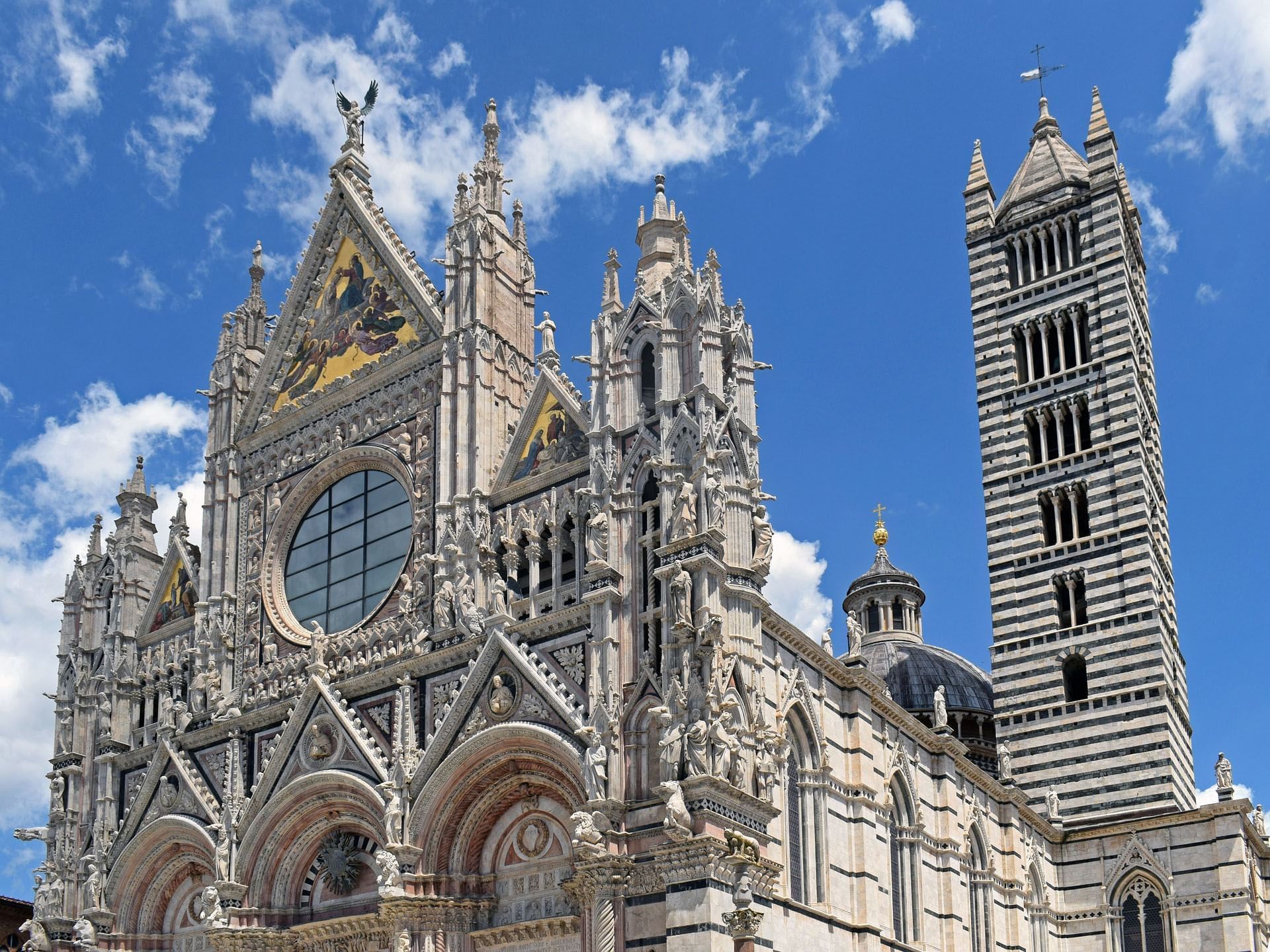Around siena
SHORT ITINERARY (from half a day to one day and a half)
The most important monuments in Siena are St Domenico’s Church, the Siena Italy Cathedral and Piazza del Campo.
The first monument that you see after parking your car is St Domenico’s Church. In a chapel on the right-hand side of the church there is the relic of St. Catherine’s head. The chapel is decorated with interesting frescoes by Sodoma representing the life of the saint. In the Cappella delle Volte you can see a fresco representing the saint, which was painted by Andrea Vanni when St Catherine was still alive. After visiting the church, you can follow Via della Sapienza until you reach Costa di S. Antonio at the end of which there is the Casa Santuario di S. Caterina (St Catherine’s Sanctuary).
Following Via della Galluzza, characterised by its typical arches, and turning to the right in Via di Diacceto, you turn to the right again thus reaching Piazza S. Giovanni. Just before reaching Piazza S. Giovanni, still in Via di Diacceto, you will see Vicolo delle Carrozze on the right-hand side where the stall of the Contrada della Selva is situated. This alley is an example of what the streets of Siena looked like in the Middle Ages. Back on Piazza S. Giovanni we can admire the Baptistery with a famous baptismal font decorated with sculptures and bronzes by Jacopo della Quercia, Lorenzo Ghiberti, Turino di Sano, Giovanni di Turino and Donatello. To reach the Cathedral, you go either up the stairs to the left of the Baptistery or follow Via dei Fusari. If you decide to go up the stairs, you can also visit the Crypt of the Cathedral. Frescoes dating from the 12th and 13th century were discovered in these rooms, which were a sort of entrance to the cathedral itself.
The colour of the frescos is still bright because the rooms were filled in with earth, thus preventing the colouring materials from oxidizing. In the Cathedral there is the famous pulpit by Nicola e Giovanni Pisano decorated with Christological scenes. The floor of the Cathedral is noteworthy too. It is composed of 52 fine inlaid marble scenes dating back to different periods and representing Biblical and profane scenes. From the Cathedral you can enter the Biblioteca Piccolomini. Pinturicchio frescoed this small room with scenes from the life of Pius II, in the world Enea Silvio Piccolomini. The two museums close to the Cathedral are well worth a visit too. Just in front of the Cathedral there is the Complesso museale del Santa Maria della Scala. In the Middle Ages it functioned as “hospital”, i.e., reception centre for pilgrims and people in need. The Santa Maria della Scala was used as hospital until a few years ago. Among the countless works of art, you can admire here there are: the sala del Pellegrinaio (Pilgrim’s Hall) with frescoes representing the daily life at the hospital and the permanent exhibition of the originals of Fonte Gaia by Jacopo della Quercia (the one on Piazza del Campo is a copy by Tito Sarrocchi dating from the 19th century). The Museo dell’Opera del Duomo lies on the nearby Piazza Jacopo della Quercia. The famous Maestà di Duccio di Buoninsegna is in this museum where you can also see the Madonna degli occhi grossi, the image which lay on the high altar of the Cathedral and at the foot of which the Sienese people, on the eve of the battle of Monteaperti (September 4th 1260), took vow to give the Blessed Virgin the keys of the town if they had won against the Florentine, which was the case.
If you follow Via del Capitano, you arrive on Piazzetta Postierla. If you go straight on, you reach the Pinacoteca Nazionale and St Agostino’s Church (now under restoration), whereas if you turn into Via di Città, you ccontinue to Piazza del Campo. Along Via di Città you will find Palazzo Chigi-Saracini which houses the Accademia musicale Chigiana and on the left-hand side Palazzo delle Papesse with its collection of contemporary art. When you arrive at Costarella, you will see Piazza del Campo on the right side. The Palio square has been the beating heart of the town since the Middle Ages. In the upper part of the square there is Fonte Gaia, a square basin feeded by the Bottini system, the underground aqueducts characterised by their barrel vault. The focal point of Piazza del Campo is the Palazzo Pubblico and the Torre del Mangia (87m, 102m to the lightning conductor) from which you can enjoy a breathtaking view over the town and the Tuscany countryside. The highlights in the Palazzo Pubblico include the Maestà and the Guidoriccio da Fogliano by Simone Martini in the Sala del Mappamondo and the frescoes cycle by Ambrogio Lorenzetti, the Allegories of Good and Bad Government, in the Sala della Pace.
If you want to go back to your car after visiting Piazza del Campo, you must follow Via Banchi di Sopra. This was one of the main streets of the mediaeval town. Along this street there are two squares: Piazza Tolomei where the Palazzo Tolomei lies and Piazza Salimbeni where the Rocca dei Salimbeni houses the Monte dei Paschi di Siena. It is possible to visit this building only on the day of the Palio. If you have some more time at your disposal, you will be able to see not only the main monuments, but also some of the less known ones.
To visit the centre of Siena you can park your car at the paying car park at the Stadium or at the free one near the Medici Fortress. To reach them follow to CENTRO/ STADIO.
THE BEST PARKING TO REACH FROM OUR HOTEL IS PARKING “IL CAMPO”, Via Fontanella 15, PORTA TUFI, – SIENA SOUTH
